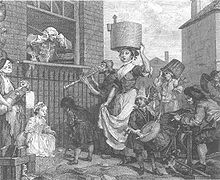The Enraged Musician
The Enraged Musician is a 1741 etching and engraving by English artist William Hogarth which depicts a comic scene of a violinist driven to distraction by the cacophony outside his window.A young girl holding a ratchet looks with amazement at a boy urinating below the musician's window (this is an often repeated image in Hogarth's work: similar scenes can be seen in The March to Finchley and in his illustrations for Hudibras and may be a reference to John Gay's "Trivia").[3] The milkmaid is flanked on either side by street musicians: to her right a man plays a hautboy, metaphorically thumbing his nose at the violinist; and to her left a small boy beats a drum.Behind these characters, a host of street vendors noisily announce their services: a dustman with a basket on his back rings a handbell, a sow-gelder blows a horn, and a fishmonger cups his hand to his mouth as he shouts.[5] While the image entertains purely by the number of references to noisy activities crammed into the scene, the play-bill for Gay's The Beggar's Opera, prominently displayed on the wall next to the musician's window, hints at developments in British music at the time.This may have been an afterthought though, as the playbill was not present in the earliest impressions, and the hautboy player and paver are usually respectively identified as Jewish and Irish, while the drummer boy is dressed in the same fashion as the young Huguenot leaving the church in Noon, the second scene of Hogarth's Four Times of the Day.[9] The presence of many street traders may also satirise Marcellus Laroon's much-copied 17th-century prints of The Cryes of the City of London and more recent images by Hogarth's rival, Giacomo Amiconi.In this version the dustman was missing his nose (a sign that he was syphilitic), a doll was placed in the model brick house in the foreground, and the drummer boy sported a Grenadier's cap.

William HogarthetchingengravingThe Distrest PoetAshmolean MuseumOxfordratcheturinatingThe March to FinchleyHudibrasJohn GayTriviaRonald PaulsonJohn SavageMarcellus LaroonhautboyfishmongerSt Martin-in-the-FieldsSt Giles-in-the-FieldsThe Beggar's OperaA Rake's ProgressMarriage à-la-modeLevéeThe Bad Taste of the TownJohn TruslerGiacobbe CervettoPietro CastrucciHandelMiltonDrydenCongreveHuguenotFour Times of the DayGiacomo AmiconiCharles LambList of works by William HogarthTate PublishingList of worksEmblematical Print on the South Sea SchemeA Just View of the British StageBefore and AfterThe Company of UndertakersStrolling Actresses Dressing in a BarnCharacters and CaricaturasIndustry and IdlenessBeer Street and Gin LaneThe Four Stages of CrueltyColumbus Breaking the EggSatire on False PerspectiveCredulity, Superstition, and FanaticismFive Orders of PeriwigsJohn Wilkes Esq.The Assembly at Wanstead HouseA Harlot's ProgressSouthwark FairScene from Shakespeare's The TempestThe Shrimp GirlPortrait of Captain Thomas CoramTaste in High LifeThe Graham ChildrenCaptain Lord George Graham in his CabinDavid Garrick as Richard IIIPainter and his PugThe Gate of CalaisHogarth's ServantsThe March of the Guards to FinchleyHumours of an ElectionSealing the TombHogarth Painting the Comic MuseThe BenchThe Lady's Last StakeSigismunda mourning over the Heart of GuiscardoMarriage A-la-ModeThe Analysis of BeautyLine of beautyHogarth's HouseSarah MalcolmHogarth ClubMary Edwards (Patron)